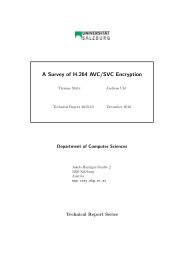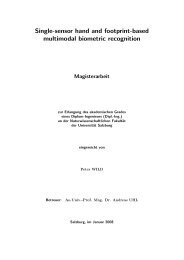Pit Pattern Classification in Colonoscopy using Wavelets - WaveLab
Pit Pattern Classification in Colonoscopy using Wavelets - WaveLab
Pit Pattern Classification in Colonoscopy using Wavelets - WaveLab
Create successful ePaper yourself
Turn your PDF publications into a flip-book with our unique Google optimized e-Paper software.
5.2 Results<br />
as we can see <strong>in</strong> figure 5.7. For the two classes case as well as for the six classes case the<br />
best results have been obta<strong>in</strong>ed with a k-value of 2.<br />
In figure 5.4 we see the results obta<strong>in</strong>ed for different choices for s <strong>in</strong> the six classes case<br />
us<strong>in</strong>g pit pattern images and the SVM classifier.<br />
As we can see from figure 5.4(a) the overall classification results seem to get higher with<br />
<strong>in</strong>creas<strong>in</strong>g values for s until a value of 33. Then the classification rate drops and rema<strong>in</strong>s<br />
constant for higher values for s.<br />
From the figures for the separate classes we aga<strong>in</strong> see, that pit pattern type III-S delivers<br />
very low results only, while all other classes def<strong>in</strong>itely show better classification results.<br />
5.2.3 Best-basis centroids (BBCB)<br />
Just like with the previous method, the best results have been achieved us<strong>in</strong>g the gray scale<br />
versions of the pit pattern images.<br />
As we can see <strong>in</strong> table 5.3, <strong>in</strong> the two classes case the best result obta<strong>in</strong>ed for the pit pattern<br />
images was 72% us<strong>in</strong>g the SVM classifier. The best result achieved with the k-NN classifier<br />
was only <strong>in</strong>significantly lower with a percentage of correctly classified images of 69%.<br />
In contrast to the BB method, both classifiers show approximately the same classification<br />
results for each separate class.<br />
In the six classes case aga<strong>in</strong> the SVM classifier outperforms the k-NN classifier with a<br />
classification result of 56% compared to 45% and the misclassification rates for pit pattern<br />
types III-S and V aga<strong>in</strong> are extremely high, just like <strong>in</strong> the previous method.<br />
The tables 5.10 and 5.11 show the result distribution matrices for the two classes case<br />
and the six classes case, respectively, us<strong>in</strong>g pit pattern images. For the two classes case the<br />
classification results are very similar to the BB method and also for the six classes case we<br />
aga<strong>in</strong> observe a poor classification performance for pit pattern types III-S and V, just like <strong>in</strong><br />
the BB method.<br />
<strong>Pit</strong> <strong>Pattern</strong> Type Non-Neoplastic Neoplastic<br />
k-NN<br />
Non-Neoplastic 66 33<br />
Neoplastic 28 71<br />
SVM<br />
Non-Neoplastic 73 26<br />
Neoplastic 28 71<br />
Table 5.10: Result distribution matrices for BBCB for 2 classes (<strong>Pit</strong> pattern images)<br />
The BBCB method has also been tested with the Outex images, which resulted <strong>in</strong> excellent<br />
classification results, as can been seen <strong>in</strong> the tables 5.4 and 5.5. In the two classes case the<br />
73








